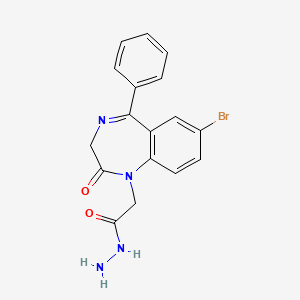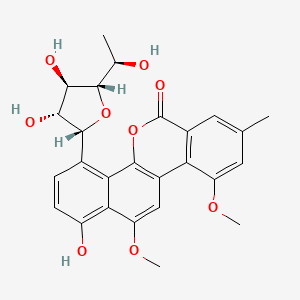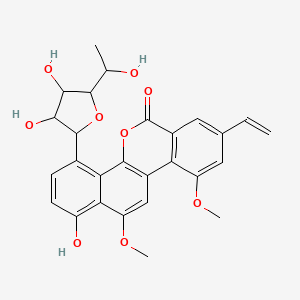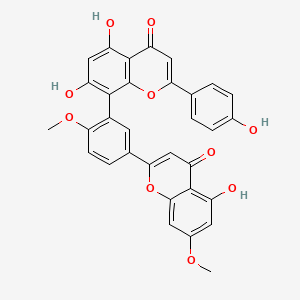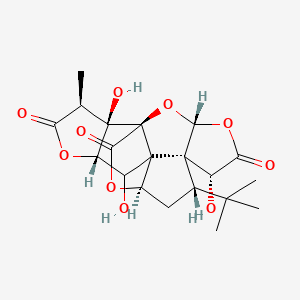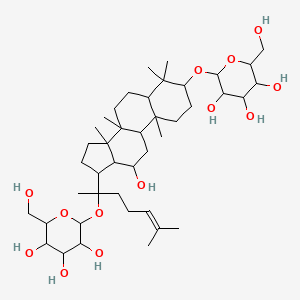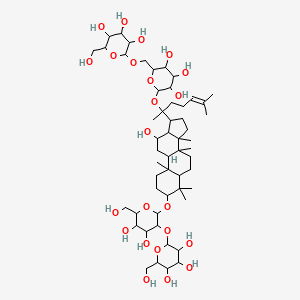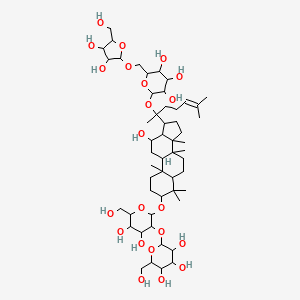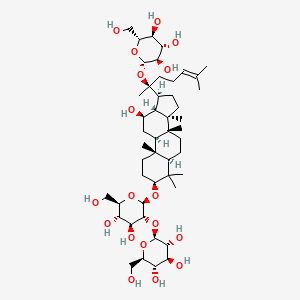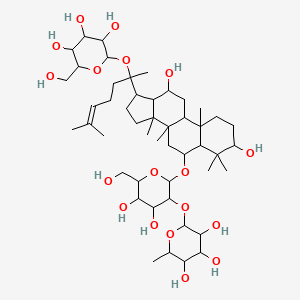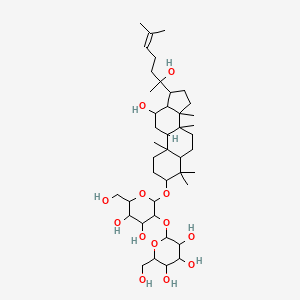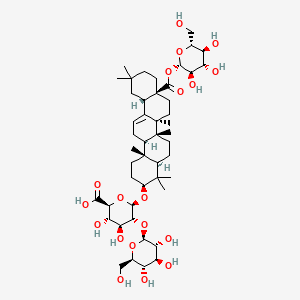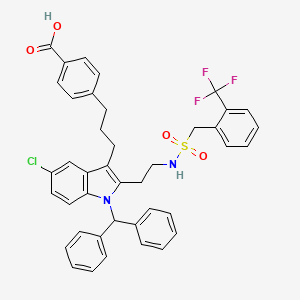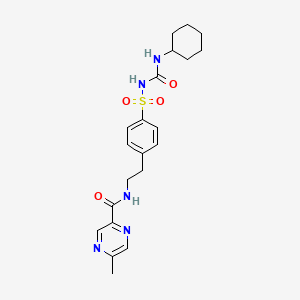
Glipizide
Vue d'ensemble
Description
Le glipizide est un agent hypoglycémique oral appartenant à la classe des sulfonylurées de deuxième génération. Il est principalement utilisé pour contrôler les niveaux de sucre dans le sang chez les patients atteints de diabète de type 2. Le this compound agit en stimulant le pancréas pour libérer de l'insuline et en augmentant la sensibilité des tissus à l'insuline . Il a été introduit pour la première fois en 1984 et est disponible sous différentes marques, notamment Glucotrol .
Applications De Recherche Scientifique
Glipizide has a wide range of scientific research applications, particularly in the fields of chemistry, biology, medicine, and industry. In medicine, it is used to control blood sugar levels in patients with type 2 diabetes mellitus . In chemistry, this compound is studied for its thermal behavior and polymorphic forms using techniques such as differential scanning calorimetry (DSC), thermogravimetric analysis (TGA), X-ray powder diffraction (XRPD), and Fourier-transform infrared spectroscopy (FT-IR) . These studies help in understanding the behavior of pharmaceutical solids and ensuring the reproducibility of industrial batches .
Mécanisme D'action
Target of Action
Glipizide primarily targets the beta cells of the pancreatic islets of Langerhans . These cells play a crucial role in the regulation of blood glucose levels by producing and releasing insulin, a hormone that promotes the uptake and utilization of glucose by the body’s cells .
Mode of Action
This compound acts by sensitizing these beta cells to the presence of glucose in the blood . This means that more insulin is released in response to glucose than would be without this compound ingestion . Specifically, this compound achieves this by partially blocking potassium channels among beta cells . This blocking action causes the cells to depolarize, which results in the opening of voltage-gated calcium channels. The resulting influx of calcium encourages the release of insulin from the beta cells .
Biochemical Pathways
The primary biochemical pathway affected by this compound is the insulin signaling pathway . By stimulating the release of insulin, this compound enhances the body’s ability to lower blood glucose levels. Insulin binds to its receptors on various body cells, triggering a cascade of events that lead to the uptake and utilization of glucose .
Pharmacokinetics
This compound is rapidly and completely absorbed following oral administration . The absolute bioavailability of this compound was found to be 100% after single oral doses in patients with type 2 diabetes mellitus . The mean terminal elimination half-life of this compound ranged from 2 to 5 hours after single or multiple doses in patients with type 2 diabetes mellitus . These properties contribute to its effectiveness as a blood glucose-lowering agent .
Result of Action
The primary result of this compound’s action is a decrease in blood glucose levels . By stimulating the release of insulin from the pancreas, this compound promotes the uptake and utilization of glucose by the body’s cells, thereby lowering blood glucose levels . This makes this compound an effective treatment for type 2 diabetes mellitus, a condition characterized by higher-than-normal levels of blood glucose .
Action Environment
The action, efficacy, and stability of this compound can be influenced by various environmental factors. For instance, the presence of food in the stomach can slow down the absorption of this compound, potentially affecting its onset of action . Additionally, the drug’s effectiveness can be influenced by the patient’s adherence to a diabetic diet and exercise regimen . Furthermore, the dose of this compound may need to be adjusted in those with liver or kidney disease , indicating that the patient’s health status can also influence the drug’s action and efficacy .
Analyse Biochimique
Biochemical Properties
Glipizide functions as an insulin secretagogue, stimulating the release of insulin from the pancreatic beta cells, thereby increasing the plasma concentrations of insulin . This action is dependent on the functional beta cells in the pancreatic islets . This compound binds to the sulfonylurea receptor expressed on the pancreatic beta-cell plasma membrane, leading to the closure of the ATP-sensitive potassium channel and reduced potassium conductance .
Cellular Effects
This compound has a significant impact on various types of cells and cellular processes. It enhances the glucose uptake into the skeletal muscles and potentiates the action of insulin in the liver . Other effects include inhibited lipolysis in the liver and adipose tissue, inhibited hepatic glucose output, and increased uptake and oxidation of glucose .
Molecular Mechanism
The molecular mechanism of this compound involves partially blocking potassium channels among beta cells of pancreatic islets of Langerhans . By blocking potassium channels, the cell depolarizes, which results in the opening of voltage-gated calcium channels. The resulting calcium influx encourages insulin release from beta cells .
Temporal Effects in Laboratory Settings
Pharmacodynamic analysis indicates a significant relationship between plasma this compound concentration and reduction in Fasting Plasma Glucose (FPG) and HbA1c over a dose range of 5–60 mg, with maximal efficacy achieved at a dose of 20 mg for FPG and at 5 mg for HbA1c .
Metabolic Pathways
This compound is metabolized primarily by hepatic transformation into several inactive metabolites by aromatic hydroxylation . A minor metabolite, an acetylamino-ethyl-benzene derivative, is reported to have some hypoglycemic activity .
Transport and Distribution
This compound is extensively bound to plasma albumin and has a relatively low volume of distribution . It is eliminated by metabolic biotransformation and excretion of the metabolites in the urine .
Subcellular Localization
The subcellular localization of this compound is primarily within the beta cells of the pancreatic islets of Langerhans . Here, it acts by partially blocking potassium channels, leading to cell depolarization and the subsequent release of insulin .
Méthodes De Préparation
Voies de synthèse et conditions réactionnelles : La synthèse du glipizide implique plusieurs étapes, en commençant par le 4-[2-(5-méthylpyrazine-2-carboxamido)éthyl]benzènesulfonamide. Les étapes clés incluent la chloration, suivie d'une réaction avec la cyclohexylamine en présence d'un catalyseur de fer et de monoxyde de carbone . Cette méthode est simple et pratique, offrant une nouvelle voie de synthèse pour la synthèse du this compound .
Méthodes de production industrielle : Dans les environnements industriels, le this compound est souvent préparé en utilisant des méthodes d'évaporation de solvant pour améliorer sa solubilité. Les dispersions solides de this compound sont préparées en utilisant des polymères tels que la polyvinylpyrrolidone (PVP) et le polyéthylène glycol (PEG). Les rapports médicament-polymère et les conditions d'évaporation du solvant sont optimisés pour atteindre les solubilités et les vitesses de dissolution souhaitées .
Analyse Des Réactions Chimiques
Types de réactions : Le glipizide subit diverses réactions chimiques, notamment l'oxydation, la réduction et la substitution. Le composé est connu pour se décomposer à la chaleur, conduisant à la formation de 5-méthyl-N-[2-(4-sulfamoylphényl)éthyl]pyrazine-2-carboxamide .
Réactifs et conditions courants : Les réactifs courants utilisés dans les réactions impliquant le this compound comprennent les catalyseurs de fer, le monoxyde de carbone et la cyclohexylamine . Le processus de décomposition implique un dégagement gazeux, notamment la cyclohexanamine et le dioxyde de carbone .
Principaux produits : Les principaux produits formés à partir de la décomposition du this compound comprennent le 5-méthyl-N-[2-(4-sulfamoylphényl)éthyl]pyrazine-2-carboxamide .
Applications de la recherche scientifique
Le this compound a un large éventail d'applications de recherche scientifique, en particulier dans les domaines de la chimie, de la biologie, de la médecine et de l'industrie. En médecine, il est utilisé pour contrôler les niveaux de sucre dans le sang chez les patients atteints de diabète de type 2 . En chimie, le this compound est étudié pour son comportement thermique et ses formes polymorphes en utilisant des techniques telles que la calorimétrie différentielle à balayage (DSC), l'analyse thermogravimétrique (TGA), la diffraction des rayons X sur poudre (XRPD) et la spectroscopie infrarouge à transformée de Fourier (FT-IR) . Ces études aident à comprendre le comportement des solides pharmaceutiques et à garantir la reproductibilité des lots industriels .
Mécanisme d'action
Le this compound exerce ses effets en sensibilisant les cellules bêta des îlots de Langerhans du pancréas à la réponse à l'insuline. Il bloque partiellement les canaux potassiques parmi les cellules bêta, ce qui conduit à une dépolarisation cellulaire et à l'ouverture des canaux calciques dépendants du voltage. L'afflux de calcium résultant encourage la libération d'insuline par les cellules bêta . Ce mécanisme contribue à abaisser les niveaux de glucose dans le sang en favorisant la sécrétion d'insuline et en augmentant la sensibilité des tissus à l'insuline .
Comparaison Avec Des Composés Similaires
Composés similaires : Le glipizide est souvent comparé à d'autres médicaments sulfonylurées tels que le glimépiride et le glyburide. Il est également comparé à des médicaments non sulfonylurées comme la metformine et les mimétiques de l'incrétine tels que la sémaglutide .
Unicité : Comparé aux autres sulfonylurées, le this compound a une absorption rapide et un début d'action avec la demi-vie et la durée d'action les plus courtes. Cela réduit le risque d'hypoglycémie de longue durée, souvent observée avec d'autres agents hypoglycémiques . De plus, la structure chimique unique du this compound, qui comprend une chaîne latérale non polaire, améliore sa puissance hypoglycémique .
Propriétés
IUPAC Name |
N-[2-[4-(cyclohexylcarbamoylsulfamoyl)phenyl]ethyl]-5-methylpyrazine-2-carboxamide | |
|---|---|---|
| Source | PubChem | |
| URL | https://pubchem.ncbi.nlm.nih.gov | |
| Description | Data deposited in or computed by PubChem | |
InChI |
InChI=1S/C21H27N5O4S/c1-15-13-24-19(14-23-15)20(27)22-12-11-16-7-9-18(10-8-16)31(29,30)26-21(28)25-17-5-3-2-4-6-17/h7-10,13-14,17H,2-6,11-12H2,1H3,(H,22,27)(H2,25,26,28) | |
| Source | PubChem | |
| URL | https://pubchem.ncbi.nlm.nih.gov | |
| Description | Data deposited in or computed by PubChem | |
InChI Key |
ZJJXGWJIGJFDTL-UHFFFAOYSA-N | |
| Source | PubChem | |
| URL | https://pubchem.ncbi.nlm.nih.gov | |
| Description | Data deposited in or computed by PubChem | |
Canonical SMILES |
CC1=CN=C(C=N1)C(=O)NCCC2=CC=C(C=C2)S(=O)(=O)NC(=O)NC3CCCCC3 | |
| Source | PubChem | |
| URL | https://pubchem.ncbi.nlm.nih.gov | |
| Description | Data deposited in or computed by PubChem | |
Molecular Formula |
C21H27N5O4S | |
| Source | PubChem | |
| URL | https://pubchem.ncbi.nlm.nih.gov | |
| Description | Data deposited in or computed by PubChem | |
DSSTOX Substance ID |
DTXSID0040676 | |
| Record name | Glipizide | |
| Source | EPA DSSTox | |
| URL | https://comptox.epa.gov/dashboard/DTXSID0040676 | |
| Description | DSSTox provides a high quality public chemistry resource for supporting improved predictive toxicology. | |
Molecular Weight |
445.5 g/mol | |
| Source | PubChem | |
| URL | https://pubchem.ncbi.nlm.nih.gov | |
| Description | Data deposited in or computed by PubChem | |
Physical Description |
Solid | |
| Record name | Glipizide | |
| Source | Human Metabolome Database (HMDB) | |
| URL | http://www.hmdb.ca/metabolites/HMDB0015200 | |
| Description | The Human Metabolome Database (HMDB) is a freely available electronic database containing detailed information about small molecule metabolites found in the human body. | |
| Explanation | HMDB is offered to the public as a freely available resource. Use and re-distribution of the data, in whole or in part, for commercial purposes requires explicit permission of the authors and explicit acknowledgment of the source material (HMDB) and the original publication (see the HMDB citing page). We ask that users who download significant portions of the database cite the HMDB paper in any resulting publications. | |
Solubility |
>66.8 [ug/mL] (The mean of the results at pH 7.4), 1.64e-02 g/L | |
| Record name | SID855947 | |
| Source | Burnham Center for Chemical Genomics | |
| URL | https://pubchem.ncbi.nlm.nih.gov/bioassay/1996#section=Data-Table | |
| Description | Aqueous solubility in buffer at pH 7.4 | |
| Record name | Glipizide | |
| Source | DrugBank | |
| URL | https://www.drugbank.ca/drugs/DB01067 | |
| Description | The DrugBank database is a unique bioinformatics and cheminformatics resource that combines detailed drug (i.e. chemical, pharmacological and pharmaceutical) data with comprehensive drug target (i.e. sequence, structure, and pathway) information. | |
| Explanation | Creative Common's Attribution-NonCommercial 4.0 International License (http://creativecommons.org/licenses/by-nc/4.0/legalcode) | |
| Record name | Glipizide | |
| Source | Human Metabolome Database (HMDB) | |
| URL | http://www.hmdb.ca/metabolites/HMDB0015200 | |
| Description | The Human Metabolome Database (HMDB) is a freely available electronic database containing detailed information about small molecule metabolites found in the human body. | |
| Explanation | HMDB is offered to the public as a freely available resource. Use and re-distribution of the data, in whole or in part, for commercial purposes requires explicit permission of the authors and explicit acknowledgment of the source material (HMDB) and the original publication (see the HMDB citing page). We ask that users who download significant portions of the database cite the HMDB paper in any resulting publications. | |
Mechanism of Action |
Type 2 diabetes mellitus (T2DM) is a chronic metabolic disorder with increasing prevalence worldwide. Characterized by higher-than-normal levels of blood glucose, T2DM is a complex disorder that arises from the interaction between genetic, environmental and behavioral risk factors. Insulin is a peptide hormone that plays a critical role in regulating blood glucose levels. In response to high blood glucose levels, insulin promotes the uptake of glucose into the liver, muscle cells, and fat cells for storage. Although there are multiple events occurring that lead to the pathophysiology of T2DM, the disorder mainly involves insulin insensitivity as a result of insulin resistance, declining insulin production, and eventual failure of beta cells of pancreatic islets that normally produce insulin. Early management with lifestyle intervention, such as controlled diet and exercise, is critical in reducing the risk of long-term secondary complications, such as cardiovascular mortality. Glipizide, like other sulfonylurea drugs, is an insulin secretagogue, which works by stimulating the insulin release from the pancreatic beta cells thereby increasing the plasma concentrations of insulin. Thus, the main therapeutic action of the drug depends on the functional beta cells in the pancreatic islets. Sulfonylureas bind to the sulfonylurea receptor expressed on the pancreatic beta-cell plasma membrane, leading to the closure of the ATP-sensitive potassium channel and reduced potassium conductance. This results in depolarization of the pancreatic beta cell and opening of the voltage-sensitive calcium channels, promoting calcium ion influx. Increased intracellular concentrations of calcium ions in beta cells stimulates the secretion, or exocytosis, of insulin granules from the cells. Apart from this main mechanism of action, the blood-glucose-lowering effect of glipizide involves increased peripheral glucose utilization via stimulating hepatic gluconeogenesis and by increasing the number and sensitivity of insulin receptors. | |
| Record name | Glipizide | |
| Source | DrugBank | |
| URL | https://www.drugbank.ca/drugs/DB01067 | |
| Description | The DrugBank database is a unique bioinformatics and cheminformatics resource that combines detailed drug (i.e. chemical, pharmacological and pharmaceutical) data with comprehensive drug target (i.e. sequence, structure, and pathway) information. | |
| Explanation | Creative Common's Attribution-NonCommercial 4.0 International License (http://creativecommons.org/licenses/by-nc/4.0/legalcode) | |
CAS No. |
29094-61-9 | |
| Record name | Glipizide | |
| Source | CAS Common Chemistry | |
| URL | https://commonchemistry.cas.org/detail?cas_rn=29094-61-9 | |
| Description | CAS Common Chemistry is an open community resource for accessing chemical information. Nearly 500,000 chemical substances from CAS REGISTRY cover areas of community interest, including common and frequently regulated chemicals, and those relevant to high school and undergraduate chemistry classes. This chemical information, curated by our expert scientists, is provided in alignment with our mission as a division of the American Chemical Society. | |
| Explanation | The data from CAS Common Chemistry is provided under a CC-BY-NC 4.0 license, unless otherwise stated. | |
| Record name | Glipizide [USAN:USP:INN:BAN] | |
| Source | ChemIDplus | |
| URL | https://pubchem.ncbi.nlm.nih.gov/substance/?source=chemidplus&sourceid=0029094619 | |
| Description | ChemIDplus is a free, web search system that provides access to the structure and nomenclature authority files used for the identification of chemical substances cited in National Library of Medicine (NLM) databases, including the TOXNET system. | |
| Record name | Glipizide | |
| Source | DrugBank | |
| URL | https://www.drugbank.ca/drugs/DB01067 | |
| Description | The DrugBank database is a unique bioinformatics and cheminformatics resource that combines detailed drug (i.e. chemical, pharmacological and pharmaceutical) data with comprehensive drug target (i.e. sequence, structure, and pathway) information. | |
| Explanation | Creative Common's Attribution-NonCommercial 4.0 International License (http://creativecommons.org/licenses/by-nc/4.0/legalcode) | |
| Record name | glipizide | |
| Source | DTP/NCI | |
| URL | https://dtp.cancer.gov/dtpstandard/servlet/dwindex?searchtype=NSC&outputformat=html&searchlist=759120 | |
| Description | The NCI Development Therapeutics Program (DTP) provides services and resources to the academic and private-sector research communities worldwide to facilitate the discovery and development of new cancer therapeutic agents. | |
| Explanation | Unless otherwise indicated, all text within NCI products is free of copyright and may be reused without our permission. Credit the National Cancer Institute as the source. | |
| Record name | Glipizide | |
| Source | EPA DSSTox | |
| URL | https://comptox.epa.gov/dashboard/DTXSID0040676 | |
| Description | DSSTox provides a high quality public chemistry resource for supporting improved predictive toxicology. | |
| Record name | Glipizide | |
| Source | European Chemicals Agency (ECHA) | |
| URL | https://echa.europa.eu/substance-information/-/substanceinfo/100.044.919 | |
| Description | The European Chemicals Agency (ECHA) is an agency of the European Union which is the driving force among regulatory authorities in implementing the EU's groundbreaking chemicals legislation for the benefit of human health and the environment as well as for innovation and competitiveness. | |
| Explanation | Use of the information, documents and data from the ECHA website is subject to the terms and conditions of this Legal Notice, and subject to other binding limitations provided for under applicable law, the information, documents and data made available on the ECHA website may be reproduced, distributed and/or used, totally or in part, for non-commercial purposes provided that ECHA is acknowledged as the source: "Source: European Chemicals Agency, http://echa.europa.eu/". Such acknowledgement must be included in each copy of the material. ECHA permits and encourages organisations and individuals to create links to the ECHA website under the following cumulative conditions: Links can only be made to webpages that provide a link to the Legal Notice page. | |
| Record name | GLIPIZIDE | |
| Source | FDA Global Substance Registration System (GSRS) | |
| URL | https://gsrs.ncats.nih.gov/ginas/app/beta/substances/X7WDT95N5C | |
| Description | The FDA Global Substance Registration System (GSRS) enables the efficient and accurate exchange of information on what substances are in regulated products. Instead of relying on names, which vary across regulatory domains, countries, and regions, the GSRS knowledge base makes it possible for substances to be defined by standardized, scientific descriptions. | |
| Explanation | Unless otherwise noted, the contents of the FDA website (www.fda.gov), both text and graphics, are not copyrighted. They are in the public domain and may be republished, reprinted and otherwise used freely by anyone without the need to obtain permission from FDA. Credit to the U.S. Food and Drug Administration as the source is appreciated but not required. | |
| Record name | Glipizide | |
| Source | Human Metabolome Database (HMDB) | |
| URL | http://www.hmdb.ca/metabolites/HMDB0015200 | |
| Description | The Human Metabolome Database (HMDB) is a freely available electronic database containing detailed information about small molecule metabolites found in the human body. | |
| Explanation | HMDB is offered to the public as a freely available resource. Use and re-distribution of the data, in whole or in part, for commercial purposes requires explicit permission of the authors and explicit acknowledgment of the source material (HMDB) and the original publication (see the HMDB citing page). We ask that users who download significant portions of the database cite the HMDB paper in any resulting publications. | |
Melting Point |
200-203, 208 - 209 °C | |
| Record name | Glipizide | |
| Source | DrugBank | |
| URL | https://www.drugbank.ca/drugs/DB01067 | |
| Description | The DrugBank database is a unique bioinformatics and cheminformatics resource that combines detailed drug (i.e. chemical, pharmacological and pharmaceutical) data with comprehensive drug target (i.e. sequence, structure, and pathway) information. | |
| Explanation | Creative Common's Attribution-NonCommercial 4.0 International License (http://creativecommons.org/licenses/by-nc/4.0/legalcode) | |
| Record name | Glipizide | |
| Source | Human Metabolome Database (HMDB) | |
| URL | http://www.hmdb.ca/metabolites/HMDB0015200 | |
| Description | The Human Metabolome Database (HMDB) is a freely available electronic database containing detailed information about small molecule metabolites found in the human body. | |
| Explanation | HMDB is offered to the public as a freely available resource. Use and re-distribution of the data, in whole or in part, for commercial purposes requires explicit permission of the authors and explicit acknowledgment of the source material (HMDB) and the original publication (see the HMDB citing page). We ask that users who download significant portions of the database cite the HMDB paper in any resulting publications. | |
Retrosynthesis Analysis
AI-Powered Synthesis Planning: Our tool employs the Template_relevance Pistachio, Template_relevance Bkms_metabolic, Template_relevance Pistachio_ringbreaker, Template_relevance Reaxys, Template_relevance Reaxys_biocatalysis model, leveraging a vast database of chemical reactions to predict feasible synthetic routes.
One-Step Synthesis Focus: Specifically designed for one-step synthesis, it provides concise and direct routes for your target compounds, streamlining the synthesis process.
Accurate Predictions: Utilizing the extensive PISTACHIO, BKMS_METABOLIC, PISTACHIO_RINGBREAKER, REAXYS, REAXYS_BIOCATALYSIS database, our tool offers high-accuracy predictions, reflecting the latest in chemical research and data.
Strategy Settings
| Precursor scoring | Relevance Heuristic |
|---|---|
| Min. plausibility | 0.01 |
| Model | Template_relevance |
| Template Set | Pistachio/Bkms_metabolic/Pistachio_ringbreaker/Reaxys/Reaxys_biocatalysis |
| Top-N result to add to graph | 6 |
Feasible Synthetic Routes
Q1: What is the primary mechanism of action of Glipizide?
A1: this compound exerts its hypoglycemic effect by binding to and blocking ATP-sensitive potassium (KATP) channels on the surface of pancreatic β-cells. [] This blockage depolarizes the β-cell membrane, leading to the opening of voltage-gated calcium channels. The subsequent influx of calcium ions triggers the exocytosis of insulin-containing granules, thereby increasing insulin secretion. [, ]
Q2: Does this compound only impact insulin secretion?
A2: While primarily recognized for enhancing insulin secretion, studies suggest that this compound might also influence insulin metabolism and peripheral glucose disposal. In obese type II diabetic patients, this compound treatment increased insulin metabolism, potentially within the liver. [] Additionally, it increased insulin-mediated peripheral glucose disposal in secondary failure type 2 diabetic patients. []
Q3: Can this compound affect glucose absorption?
A3: While initial studies suggested this compound might suppress xylose absorption in diet-controlled diabetics, further research revealed no such effect in insulin-dependent diabetics. [] This suggests that this compound's impact on postprandial glucose levels is primarily due to enhanced insulin secretion rather than altered absorption.
Q4: What is the molecular formula and weight of this compound?
A4: this compound (C21H27N5O4S) has a molecular weight of 445.55 g/mol. [, ]
Q5: Are there any spectroscopic data available for this compound?
A5: Yes, various spectroscopic techniques have been employed to characterize this compound. Fourier-transform infrared (FTIR) spectroscopy has been used to analyze this compound's stability and interactions with excipients in formulations like solid dispersions and bilayer tablets. [, , ] Additionally, differential scanning calorimetry (DSC) and X-ray diffraction (XRD) studies have revealed the amorphous nature of this compound in solid dispersions. []
Q6: What is the stability of this compound in various formulations?
A6: this compound stability has been investigated in various formulations. Studies demonstrate its stability in solid dispersions with low viscosity grade Hydroxypropyl methylcellulose (HPMCLV), even after storage. [] Bilayer tablet formulations with Hydroxypropyl methylcellulose (HPMC) and Ethyl Cellulose (EC) also exhibited stability according to ICH guidelines. []
Q7: Are there any known compatibility issues with this compound?
A7: While generally stable, certain drug interactions can impact this compound's effectiveness. For instance, co-administration with Nicorandil in diabetic mice hindered the glucose-lowering effects of this compound. [] Therefore, careful consideration is crucial when co-administering this compound with other medications.
Q8: How is this compound absorbed and metabolized?
A8: this compound is well-absorbed after oral administration. [] Food delays its absorption, unlike Glyburide. [] this compound undergoes extensive hepatic metabolism, and both metabolites and the unchanged drug are excreted in urine. []
Q9: What is the elimination half-life of this compound?
A9: this compound exhibits a short elimination half-life ranging from 2 to 7 hours. [] Its short half-life necessitates frequent dosing or the use of extended-release formulations to maintain therapeutic efficacy.
Q10: Are there any known drug interactions that affect this compound pharmacokinetics?
A11: Yes, several drugs can influence this compound pharmacokinetics. Clarithromycin significantly inhibits its metabolism in rabbits, leading to higher this compound exposure. [] Additionally, Esomeprazole, a proton pump inhibitor, can increase this compound concentration and AUC (area under the curve) by inhibiting Cytochrome P-450 enzymes responsible for its metabolism. []
Q11: What animal models have been used to investigate the effects of this compound?
A11: Various animal models have been employed, including:
- Diabetic-prone BB rats: Demonstrated this compound's ability to prevent diabetes and reduce islet inflammation. []
- Healthy and diabetic rabbits: Used to study the influence of drugs like Clarithromycin [] and Puerarin [] on this compound pharmacokinetics.
- Healthy cats: Investigated transdermal application of this compound. []
- Healthy and endotoxemic sheep: Studied the effects of this compound on cardiopulmonary hemodynamics and oxygen transport. []
- Alloxan-induced diabetic rats: Assessed the combined effect of this compound and alpha lipoic acid on diabetic parameters and hepatic function. []
Q12: How effective is this compound in controlling blood glucose levels compared to other treatments?
A12: Studies have compared this compound's efficacy to other treatments:
- Glyburide: In a Veterans Health Administration study, converting from Glyburide to this compound increased HbA1c levels, but reduced the incidence of hypoglycemia. []
Q13: How does this compound's low solubility affect its formulation?
A15: this compound's low solubility (BCS Class II drug) poses challenges for formulation and can limit its bioavailability. [, ] Various strategies have been explored to enhance its solubility and dissolution rate.
Q14: What formulation strategies have been investigated to improve this compound delivery?
A14: Several approaches have been explored to enhance this compound delivery:
- Solid Dispersions: Utilizing low viscosity grade HPMCLV improved this compound's dissolution rate. []
- Nano-complexes: this compound-Phospholipid nano-complexes demonstrated improved solubility and bioavailability in rats. []
- Microspheres: Ethyl Cellulose microspheres showed potential for sustained this compound release. []
- Transdermal Delivery: Studies explored transdermal patches incorporating this compound-cyclodextrin complexes and penetration enhancers, achieving sustained drug release and therapeutic effects in diabetic rats. []
Q15: Have any specific cyclodextrins shown promise in enhancing this compound solubility?
A17: Yes, complexation with cyclodextrins, especially Dimethyl-beta-cyclodextrin (DM-beta-CyD), significantly improved this compound release and permeation through rat skin in transdermal formulations. []
Q16: What is the rationale behind developing a transdermal delivery system for this compound?
A18: Transdermal delivery of this compound aims to address the limitations of oral therapy, such as fluctuating bioavailability, risk of severe hypoglycemia, and gastric disturbances. []
Avertissement et informations sur les produits de recherche in vitro
Veuillez noter que tous les articles et informations sur les produits présentés sur BenchChem sont destinés uniquement à des fins informatives. Les produits disponibles à l'achat sur BenchChem sont spécifiquement conçus pour des études in vitro, qui sont réalisées en dehors des organismes vivants. Les études in vitro, dérivées du terme latin "in verre", impliquent des expériences réalisées dans des environnements de laboratoire contrôlés à l'aide de cellules ou de tissus. Il est important de noter que ces produits ne sont pas classés comme médicaments et n'ont pas reçu l'approbation de la FDA pour la prévention, le traitement ou la guérison de toute condition médicale, affection ou maladie. Nous devons souligner que toute forme d'introduction corporelle de ces produits chez les humains ou les animaux est strictement interdite par la loi. Il est essentiel de respecter ces directives pour assurer la conformité aux normes légales et éthiques en matière de recherche et d'expérimentation.


